Entries from November 24, 2013 - November 30, 2013
UK's Carney should worry about dishoarding, not mythical mortgage boom
UK monetary conditions remain expansionary but this does not reflect any boom in mortgage lending – yesterday’s changes to the funding for lending scheme, although probably inconsequential, were misguided.
Six-month growth of real non-financial M1* – the favoured monetary aggregate here – eased back in October but remained robust at 4.4%, or 9.1% annualised. Growth of real non-financial M4 is much lower but was little changed in October at 1.0%, or 1.9% annualised – see first chart.
As in the Eurozone but to a greater extent, economic strength is being driven by households and firms “dishoarding”, i.e. mobilising existing monetary savings, rather than by rapid expansion of broad money and credit. Such dishoarding involves a shift of funds out of time deposits and notice accounts into M1, explaining its superior forecasting performance. Put differently, the velocity of circulation of the existing stock of broad money is increasing.
Credit weakness is gradually abating but the stock of net lending to individuals, excluding student loans, grew by only 1.6% annualised in the latest three months. Talk of a borrowing binge, in other words, is nonsense. As previously discussed, repayments of mortgage debt have risen more or less in line with gross advances, resulting in little change in the net lending flow – second chart.
If economic strength caused by dishoarding / rising velocity is judged to pose an inflationary risk, the appropriate policy action is to raise Bank rate rather than throw another spanner in the credit machinery. A Bank rate hike would filter through to deposit rates, reducing the incentive to spend monetary savings. The knock-on effect on borrowing rates could be mitigated by making funding for lending and the capital regime more, not less, generous.
*Non-financial M1 = sterling notes / coin and sight deposits of households and private non-financial firms. M4 = M1 plus other sterling deposits, repos, bank bills / commercial paper and other bank securities of up to five years’ original maturity.
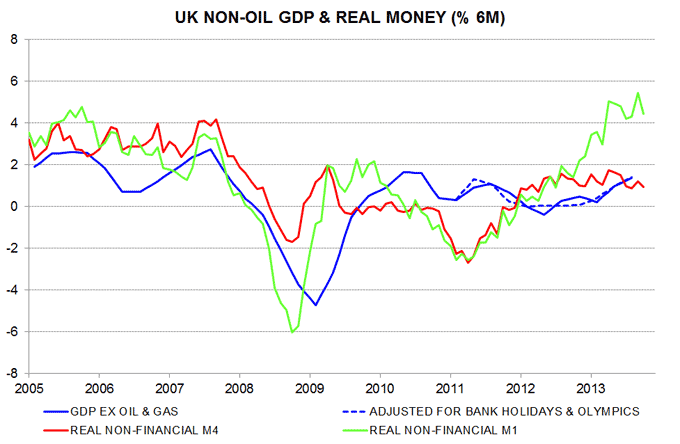
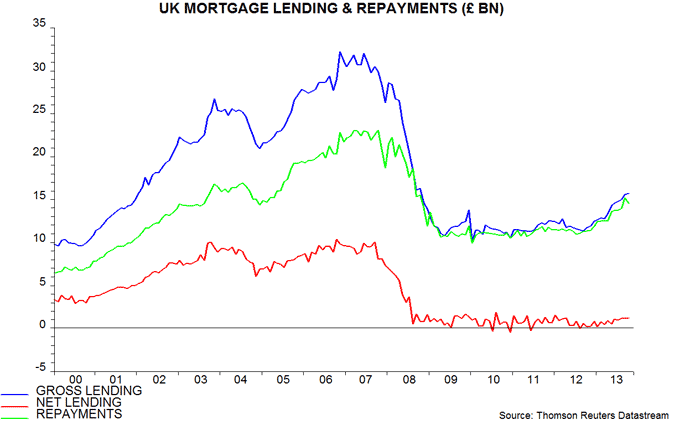
Eurozone money numbers: economic recovery reflects "dishoarding"
Eurozone monetary trends are judged here to be consistent with a continued but sluggish economic recovery in early 2014.
Consensus commentary is likely to view October numbers as poor, since the annual rates of change of broad money M3 and loans to the private sector* fell – from 2.0% to 1.4% and -1.6% to -1.7% respectively. Narrow money M1, however, has far superior forecasting properties and continues to expand respectably – by an annual 6.6% in October versus 6.7% in September. The shorter-term trend, moreover, is stronger – M1 rose by 1.0% in October alone and by 1.9%, or 7.8% annualised, in the latest three months.
ECB research** has identified real (i.e. inflation-adjusted) non-financial M1, comprising holdings of households and non-financial firms, as the best monetary leading indicator of the economy. Six-month growth of this measure has eased since May but remained solid at 2.9%, or 6.0% annualised, in October – see first chart.
The interpretation here is that weak credit supply and demand are continuing to depress lending and broad money but this is not preventing an economic recovery because households and firms are mobilising existing monetary resources to increase spending. Such “dishoarding” is a response to low interest rates and increased confidence in financial stability, and is being reflected in an ongoing transfer of funds out of time deposits and notice accounts into M1.
Deflation worries, accordingly, are exaggerated. Current low inflation is mainly the consequence of monetary restriction in 2011, when the ECB raised official rates despite weakness in both M1 and M3. Stronger M1 growth in 2012-13 suggests that inflation will stabilise and firm in 2014-15. Downside risk stems not from domestic monetary conditions but from upward pressure on the euro / dollar exchange rate, caused partly by the Federal Reserve reneging on its commitment to taper QE.
The country breakdown of M1 deposits continues to show slower real growth in the peripheral grouping (i.e. Italy, Spain, Greece, Portugal, Ireland) but September weakness was partially reversed last month – second chart. Italy / Spain are lagging Germany / France, although divergences are small by the standards of recent years; growth, by contrast, is strong in the three IMF bailout countries – third chart.
*Adjusted for sales and securitisation.
**See “Stylised facts of money and credit over the business cycle”, ECB Monthly Bulletin October 2013, pp18-22.



UK mortgage lending pick-up offset by increased repayments - net lending still weak
As previously discussed, the commonly-held view that recent stronger UK economic growth reflects consumers gearing up to finance higher spending is not supported by evidence. The stock of lending to individuals, excluding student loans, rose by only 1.0% in the year to September*, while employee compensation – the product of average compensation and employee numbers – gained an annual 3.6% in the third quarter, according to today’s national accounts release.
Undaunted, the debt worriers argue that lending is about to take off, citing a recent surge in mortgage approvals – up by 35% in value terms in the year to September according to comprehensive Bank of England data, with British Bankers’ Association members this week reporting a 31% increase in October. As explained below, however, this surge has already largely fed through to gross mortgage advances but net lending has remained weak. A rise in loan repayments, in other words, has offset the pick-up in gross lending. Stronger net lending, therefore, requires either a further increase in approvals or a slowdown in repayments.
Mortgages on dwellings account for 89% of the stock of lending to individuals. Gross mortgage advances were £15.6 billion in September versus a monthly average of £11.9 billion in 2012, an increase of 31%. Mortgage approvals rose only slightly more over the same period – from £12.0 billion to £16.0 billion, or 33%. So gross advances already largely reflect recent higher approvals.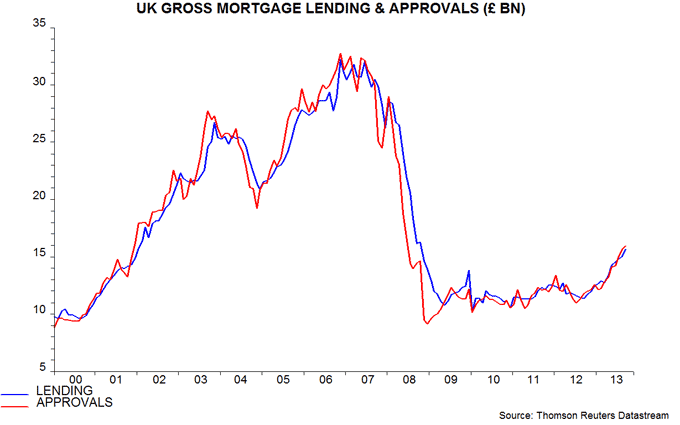
Net lending, by contrast, remains weak – £1.0 billion in September versus a 2012 average of £700 million. A rise in principal repayments has almost exactly matched the pick-up in gross advances.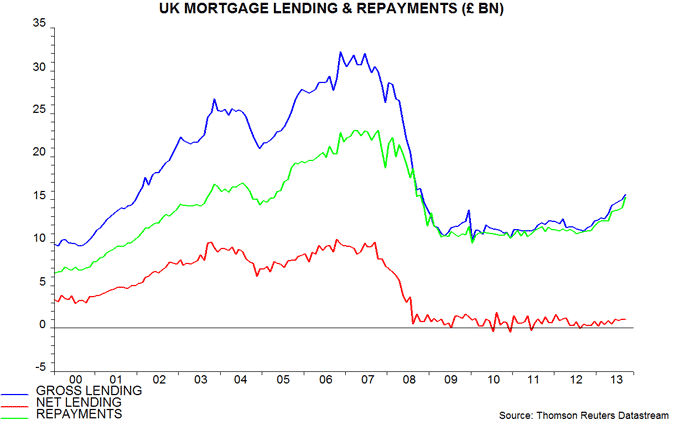
The next chart breaks the principal paydown into redemptions and other repayments. Both have increased this year. The rise in redemptions is mostly due to higher remortgaging activity as the funding for lending scheme has allowed borrowers to refinance on more attractive terms. Regular repayments, however, have also increased significantly. This may partly reflect borrowers who have refinanced at a lower interest rate maintaining their monthly payments, resulting in a larger repayment component.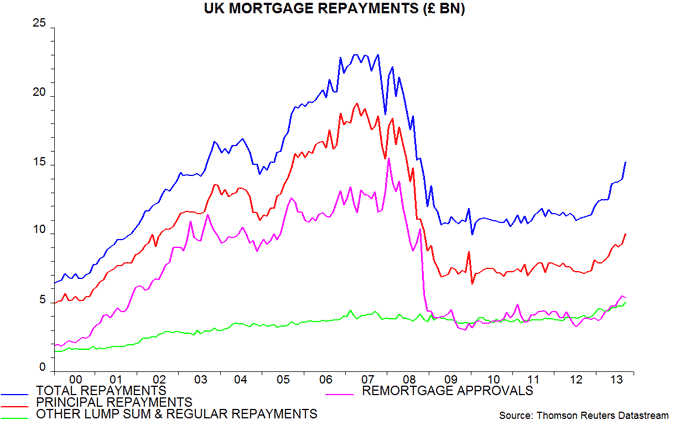
Assuming that repayments continue at their current rate, mortgage approvals need to rise significantly further to signal that consumers are regearing. Consider a scenario in which overall lending growth strengthens from an estimated 1.25% during 2013 (i.e. December to December) to 5% in 2014, with the increase driven by mortgage credit. 5% lending expansion would require a monthly net mortgage flow of £5.1 billion versus £1.0 billion in September 2013. So gross mortgage lending and approvals would need to rise by a further £4.1 billion per month, or 26%.
5% lending growth, of course, would be modest by historical standards and might not exceed income expansion, assuming a continued economic pick-up. A 10% lending increase would require mortgage approvals to climb by more than 60% from the September level.
The help to buy guarantee scheme should contribute to mortgage approvals strengthening further but a rise of 26%, let alone 60%, is doubtful. The government announced earlier this month that 2,384 borrowers had mortgages approved under the scheme in the first four weeks of its operation. This amounts to 3.0% of the number of mortgage approvals for house purchase in September (66,735). Some of these borrowers would probably have obtained mortgages in the absence of the scheme, albeit on more expensive terms.
*October money and lending data are released on Friday.

